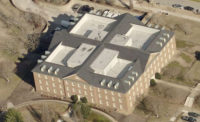New Orleans’ $2.3B Public Works Program Gains Momentum

Palmisano construction crews excavate a portion of Canal Boulevard in New Orleans before installing a new catch basin. The project is one of nearly 200 that are part of a $2.3 billion public works program in New Orleans.
Photo courtesy of the city of New Orleans
At a time when state and local governments are pining for federal infrastructure funding, the city of New Orleans is making headway on a $2.3 billion public works program, the largest of its kind in a generation.
As of March 4, construction was under way on 73 projects, totaling $562 million, city officials told ENR. The city will have another $110 million in roadway projects and $100 million in green infrastructure projects out for bid in the next few months. The New Orleans Dept. of Public Works and the city’s Sewerage and Water Board is overseeing the program, which encompasses nearly 200 projects to reconstruct aging roads, drainage and sewer systems across the city.
With the COVID-19 pandemic putting a severe strain on the city’s tax base, the public works program has gained momentum at a critical time, and local bond dollars helped the program move forward, says Ramsey Green, deputy chief administrative officer for the city of New Orleans.
“While you’re seeing a slowdown in the tourism and hospitality-based economy, the construction industry – particularly those companies that are focused on public infrastructure – has actually seen a bit of a boom,” Green says. “And our price elasticity has remained fairly stable because on the private side, there’s probably less work happening. So we used our bond money as a local stimulus.”
Access to local bond revenues was the key to unlocking a portion of the program’s funding, much of which is from a $1.8 billion settlement from the Federal Emergency Management Agency (FEMA) to reimburse the city for Hurricane Katrina-related repairs to damaged streets and underground utilities.
In November 2019, New Orleans voters approved a measure allowing the city to issue up to $500 million in bonds for capital improvements over a five-year period.
FEMA gave the city a deadline to spend the infrastructure money by the end of 2023; the catch was that the city needed to front the money and then be reimbursed later. The bonds provided the city with the cash flow it needed to fill in funding gaps for planned FEMA projects.
Powering through a pandemic
At the start of 2020, the city was just getting ready to kick its roadwork projects into high gear and announced plans to start work on $588 million in FEMA-funded projects in 2020. Under the previous mayoral administration, the program had faced scrutiny for long stretches of inactivity during the previous mayoral administration.
Then in March, the COVID-19 pandemic presented another setback.
Although construction was still considered an essential business when the pandemic hit, the city and its contractors had to work with mandatory shutdowns of other businesses and with jobsite safety protocols for mask wearing and social distancing.
“COVID has brought us so many challenges that were unexpected,” says Brett Ruppel, team leader for civil projects for Palmisano, one of the contractors on the city’s road projects.
During mandatory shutdowns, the firm was restricted from performing waterline work, which meant having to modify its schedule and build outside of its original sequence.
In addition to COVID, another challenge has been maintaining access for residents and pedestrians around the jobsite. “The team sequences the work so there are not adjacent streets being worked on that would disrupt and displace all of the residents,” Ruppel says.
The contractor has also had to keep up with commodity materials pricing, as costs related to steel, plastics and oil have continued to climb. “We lock in these prices as soon as possible and buy the material in bulk where we can so that we don’t take the short end of the deal, but there are not pricing protections that account for unforeseen increases,” Ruppel says.
‘Dramatic progress’
Despite setbacks from COVID and an active hurricane season, Green says the program has been able to maintain its momentum. As of March 4, the city had completed about $142 million in roadwork projects since Mayor LaToya Cantrell took office in 2018.
“We’ve seen some dramatic progress, and we have a lot of companies that are very pleased that this progress continues, despite a global pandemic that unusually impacted our city,” Green says.
For Palmisano, civil projects like these have become a significant part of the company’s revenue stream, Ruppel says. The firm has been working on infrastructure recovery roads projects in the neighborhoods of Lakeview, Gentilly and New Orleans East since 2017. The firm completed its first project for the program in 2019. Other projects are in varying stages of completion.
“The great thing about these projects is they are spread all over the city, and no matter what job we are on, we are usually improving someone in the organization’s neighborhood. That feels good, and we are proud of the work we have done,” he says.


